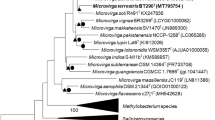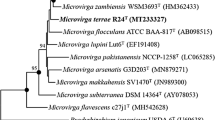Abstract
Two bacterial strains, BT325T and BT690, were isolated from soil samples collected in Korea. Both strains were Gram stain-negative, short rod-shaped, and formed light-pink colored colonies. The 16S rRNA sequence similarity of strains BT325T and BT690 shared a sequence similarity of 99.7%. Both strains shared the highest 16S rRNA gene similarity of 98.6% with Microvirga arabica SV2184PT, followed by Microvirga ossetica V5/3 M T (98.5% and 98.2%, respectively), Microvirga soli R491T (98.3% and 98.2%, respectively), Microvirga aerilata (98.2% and 98.08%, respectively), Microvirga makkahensis (98.08% and 97.8%, respectively). Phylogenetic analyses based on 16S rRNA gene sequences revealed that strain BT325T and BT690 were positioned in a distinct lineage within the family Methylobacteriaceae (order Rhizobiales, class Alphaproteobacteria). The genome size of strain BT325T was 5,200,315 bp and the genomic DNA G + C content was 64.3 mol%. The sole respiratory quinone of strain BT325T was Q-10 and the predominant cellular fatty acids were summed feature 3 (C16:1 ω7c/C16:1 ω6c) and summed feature 8 (C18:1 ω7c/C18:1 ω6c). The major polar lipids were diphosphatidylglycerol, phosphatidylglycerol, phosphatidylethanolamine, and phosphatidylcholine. Polyphasic taxonomic analysis of biochemical, chemotaxonomic, and phylogenetic analyses suggested that strains BT325T represents a novel bacterial species within the genus Microvirga, for which the name Microvirga splendida is proposed. The type strain of Microvirga splendida is BT325T (= KCTC 72406 T = NBRC 114847 T).


Similar content being viewed by others
Abbreviations
- R2A:
-
Reasoner’s 2A
- KACC:
-
Korean agricultural culture collection
- NA:
-
Nutrient agar
- LBA:
-
Laked Blood Agar
- TSA:
-
Tryptic Soy Agar
- MAC:
-
MacConkey
- PGAP:
-
Prokaryotic genome annotation pipeline
- ANI:
-
Average nucleotide identity
- DDH:
-
In silico DNA–DNA hybridization
- NJ:
-
Neighbor-joining
- ML:
-
Maximum–likelihood
- MP:
-
Maximum–parsimony
- HPLC:
-
High performance lipid chromatography
- TLC:
-
Thin layer chromatography
- FAME:
-
Fatty acid methyl esters
- MIS:
-
Microbial identification system
- CDS:
-
Coding genes
- DPG:
-
Diphosphatidylglycerol
- PG:
-
Phosphatidylglycerol
- PE:
-
Phosphatidylethanolamine
- PC:
-
Phosphatidylcholine
- L:
-
Unidentified polar lipid
- AL:
-
Unidentified aminolipid
References
Ardley JK, Parker MA, De Meyer SE, Trengove RD, O’Hara GW, Reeve WG, Yates RJ, Dilworth MJ, Willems A, Howieson JG (2012) Microvirga lupini sp. nov., Microvirga lotononidis sp. nov. and Microvirga zambiensis sp. nov. are alphaproteobacterial root-nodule bacteria that specifically nodulate and fix nitrogen with geographically and taxonomically separate legume hosts. Int J Syst Evol Microbiol 62:2579–2588
Cappuccino JG, Sherman N (2002) Microbiology—a laboratory manual, 6th edn. Pearson Education, Inc., Benjamin Cummings, California
Felsenstein J (1981) Evolutionary trees from DNA sequences: a maximum likelihood approach. J Mol Evol 17:368–376
Felsenstein J (1985) Confidence limit on phylogenies: an approach using the bootstrap. Evolution 39:783–791
Fitch WM (1971) Toward defining the course of evolution: minimum change for a specific tree topology. Syst Zool 20:406–416
Hiraishi A, Ueda Y, Ishihara J, Mori T (1996) Comparative lipoquinone analysis of influent sewage and activated sludge by high performance liquid chromatography and photodiode array detection. J Gen Appl Microbiol 42:457–469
Kanso S, Patel BKC (2003) Microvirga subterranea gen. nov., sp. nov., a moderate thermophile from a deep subsurface Australian thermal aquifer. Int J Syst Evol Microbiol 53:401–406
Kimura M (1983) The neutral theory of molecular evolution. Cambridge University Press, Cambridge
Komagata K, Suzuki K (1988) 4 Lipid and cell-wall analysis in bacterial systematics. Method Microbiol 19:161–207
Konstantinidis KT, Tiedje JM (2005) Genomic insights that advance the species definition for prokaryotes. Proc Natl Acad Sci USA 102:2567–2572
Kumar S, Stecher G, Li M, Knyaz C, Tamura K (2018) MEGA X: Molecular evolutionary genetics analysis across computing platforms. Mol Biol Evol 35:1547–1549
Lee I, Kim YO, Park CJ (2016) OrthoANI: an improved algorithm and software for calculating average nucleotide identity. Int J Syst Evol Microbiol 66:1100–1103
Li J, Gao R, Chen Y, Xue D, Han J, Wang J, Dai Q, Lin M, Ke X, Zhang W (2020) Isolation and Identification of Microvirga thermotolerans HR1, a novel thermo-tolerant bacterium, and comparative genomics among Microvirga species. Microorganisms 8:101
Meier-Kolthoff JP, Auch AF, Klenk HP, Göker M (2013) Genome sequence–based species delimitation with confidence intervals and improved distance functions. BMC Bioinform 14:60
Minnikin DE, O’Donnell AG, Goodfellow M, Alderson G, Athalye M, Schaal A, Parlett JH (1984) An integrated procedure for the extraction of bacterial isoprenoid quinones and polar lipids. J Microbiol Meth 2:233–241
Msaddak A, Rejili M, Durán D, Mars M, Palacios JM, Ruiz-Argüeso T, Rey L, Imperial J (2019) Microvirga tunisiensis sp. nov., a root nodule symbiotic bacterium isolated from Lupinus micranthus and L. luteus grown in Northern Tunisia. Syst Appl Microbiol 42:126015
Na SI, Kim YO, Yoon SH, Ha SM, Baek I, Chun J (2018) UBCG: Up-to-date bacterial core gene set and pipeline for phylogenomic tree reconstruction. J Microbiol 56:280–285
Safronova VI, Kuznetsova IG, Sazanova AL, Belimov AA, Andronov EE, Chirak ER, Osledkin YS, Onishchuk OP, Kurchak ON, Shaposhnikov AI, Willems A, Tikhonovich IA (2017) Microvirga ossetica sp. nov., a species of rhizobia isolated from root nodules of the legume species Vicia alpestris Steven. Int J Syst Evol Microbiol 67:94–100
Saitou N, Nei M (1987) The neighbor-joining method: a new method for reconstructing phylogenetic trees. Mol Biol Evol 4:406–425
Sasser M (1990) Identification of bacteria by gas chromatography of cellular fatty acids. MIDI Technical Note 101. Newark, DE: MIDI Inc
Smibert RM, Krieg NR (1981) General characterization. Manual of methods for general bacteriology. American Society for Microbiology, Washington DC, pp 409–442
Tatusova T, DiCuccio M, Badretdin A et al (2016) NCBI prokaryotic genome annotation pipeline. Nucleic Acids Res 44:6614–6624
Veyisoglu A, Tatar D, Saygin H, Inan K, Cetin D, Guven K, Tuncer M, Sahin N (2016) Microvirga makkahensis sp. nov. and Microvirga arabica sp. nov. isolated from sandy arid soil. Antonie Van Leeuwenhoek 109:287–296
Weisburg WG, Barns SM, Pellerier DA, Lane DJ (1991) 16S ribosomal DNA amplification for phylogenetic study. J Bacteriol 173:697–703
Weon HY, Kwon SW, Son JA, Jo EH, Kim SJ, Kim YS, Kim BY, Ka JO (2010) Description of Microvirga aerophila sp. nov. and Microvirga aerilata sp. nov. isolated from air reclassification of Balneimonas flocculans Takeda et al. 2004 as Microvirga flocculans comb. Nov. and emended description of the genus Microvirga. Int J Syst Evol Microbiol 60:2596–2600
Zhang XJ, Zhang J, Yao Q, Feng GD, Zhu HH (2019) Microvirga flavescens sp. nov., a novel bacterium isolated from forest soil and emended description of the genus Microvirga. Int J Syst Evol Microbiol 69:667–671
Zhu L, Ping W, Zhang S, Chen Y, Zhang Y, Zhang J (2021) Description and genome analysis of Microvirga antarctica sp. nov., a novel pink-pigmented psychrotolerant bacterium isolated from Antarctic soil. Antonie Van Leeuwenhoek 114:2219–2228
Zilli JE, Passos SR, Leite J, Xavier GR, Rumjaneck NG, Simoes-Araujo JL (2015) Draft genome sequence of Microvirga vignae strain BR 3299T, a novel symbiotic nitrogen-fixing alphaproteobacterium isolated from a Brazilian semiarid region. Genome Announc 3:e00700-e715
Acknowledgements
We are grateful to Prof. Aharon Oren (The Hebrew University of Jerusalem, Israel) for helping with the etymology.
Funding
This work was supported by a research grant from the National Institute of Biological Resources (NIBR), funded by the Ministry of Environment (MOE) of the Republic of Korea (NIBR202002203), by a research grant from Seoul Women’s University (2022-0320), and by the National Research Foundation of Korea (NRF) grant funded by the Korea government (MSIT) (No. 2020R1G1A110144).
Author information
Authors and Affiliations
Contributions
All authors equally contributed in this work.
Corresponding authors
Ethics declarations
Conflict of interest
All authors certify that there is no conflict of interest.
Additional information
Publisher's Note
Springer Nature remains neutral with regard to jurisdictional claims in published maps and institutional affiliations.
The GenBank accession numbers for the 16S rRNA gene sequences of strains BT325T and BT690 are MT795758 and MW463443, respectively. The whole-genome sequences of strain BT325T have been deposited into DDBJ/EMBL/GenBank under the accession number JAELXT000000000.
Supplementary Information
Below is the link to the electronic supplementary material.
Rights and permissions
About this article
Cite this article
Park, Y., Maeng, S., Damdintogtokh, T. et al. Microvirga splendida sp. nov., bacteria isolated from soil. Antonie van Leeuwenhoek 115, 741–747 (2022). https://doi.org/10.1007/s10482-022-01715-x
Received:
Accepted:
Published:
Issue Date:
DOI: https://doi.org/10.1007/s10482-022-01715-x




